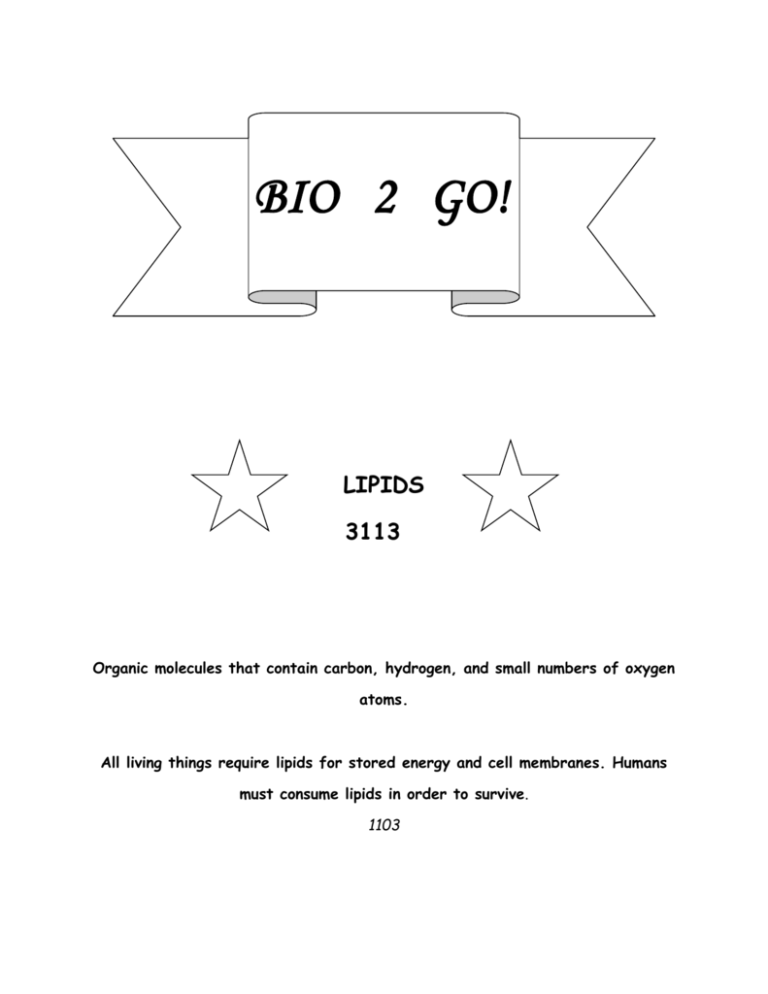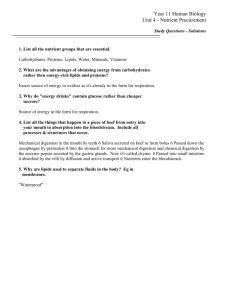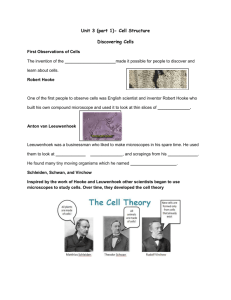(3 - HomeworkNOW.com
advertisement

BIO 2 GO! LIPIDS 3113 Organic molecules that contain carbon, hydrogen, and small numbers of oxygen atoms. All living things require lipids for stored energy and cell membranes. Humans must consume lipids in order to survive. 1103 LIPIDS 3113 By the end of this unit of study, you should be able to do the following. 1. Compare the structure of a carbohydrate to a lipid. 2. Compare the function of lipids and carbohydrates. 3. List the two types of lipid. 4. List, describe, and explain the function of each type of lipid. 5. Be able to demonstrate your understanding of the following words: Lipid Carbohydrate Fats Long-term energy Phospholipids storage Lipids 3113 Lipids are also organic molecules and are similar to carbohydrates. Both lipids and carbohydrates are used by organisms for energy, but lipids also serve many other purposes. Like carbohydrates, all lipids contain carbon, hydrogen, and oxygen, but these molecules have very few oxygen atoms. In fact, the hydrogen to oxygen ration is always greater than 2:1. This means that there are always more than 2 hydrogen atoms present for every oxygen atom. This is a major difference between carbohydrates (remember -they have a 2:1 ration of hydrogen to oxygen) and lipids. We will be studying 2 types of lipid: fats, and phospholipids. Although lipids have many functions, we will concentrate on 2 major functions: 1) long-term stored energy (fats) 2) cell membrane building materials (phospholipids) REMEMBER THIS!!! Lipids are like carbohydrates but they contain less oxygen. Both are made from carbon, hydrogen, and oxygen. 2 Types of Lipids: 1) Fats are a particular type of lipids that you are probably familiar with. They are used for storing energy. In a living organism, when the supply of carbohydrates is low, fats are converted into energy. Interesting Scientific Fact: Humans use their carbohydrates for energy before we use the lipids (fats) as energy. In some cases, stored lipid energy (fat) is seldom used. That is why it is so difficult for some people to lose weight. 2) Phospholipids are also a type of lipid. This molecule has a polar end and a nonpolar end so it is used to make cell membranes in plants, animals, and a particular type of animal known as humans. Example of a phospholipid Interesting Scientific Fact: Every living thing is composed of one or more cells. The cell membrane contains the cell and determines what goes into and out of every cell. Healthy cells have healthy cell membranes. Diseases often occur when the cell membrane is attacked. Diagram of a healthy cell membrane. Self Test Question 1. List, describe, and explain the 2 functions of lipids. Question 2. List, describe, and explain the 2 types of lipids. Matching (there will be more than I answer for most) _____1. lipids a. this type of molecule is similar to a carbohydrate _____ 2. fats b. organic molecules made of carbon, hydrogen and _____ 3. phospholipids a few oxygen atoms d. lipid used for long-term energy storage e. lipid used to make cell membranes f. used after carbohydrate energy sources are depleted True or False _____ 1. Lipids are used only for energy in a cell. _____ 2. Lipids are used for many different functions. _____ 3. Lipids contain carbon, nitrogen, and oxygen. _____ 4. Fats are a type of carbohydrate. _____ 5. Fats are a source of long-term stored energy. _____ 6. Phospholipids are used to make cell membranes. _____ 7. Phospholipids are organic molecules. _____ 8. All lipids are organic molecules. _____ 9. Lipids are similar to carbohydrates. _____ 10. Lipids are required to make new cells.






